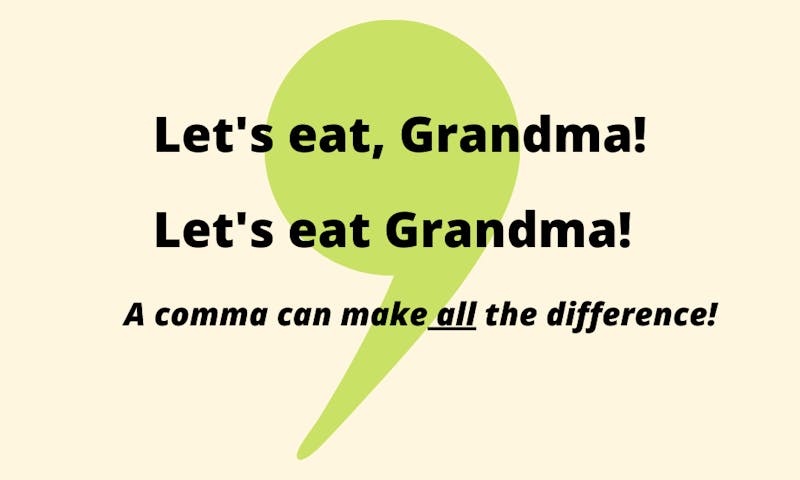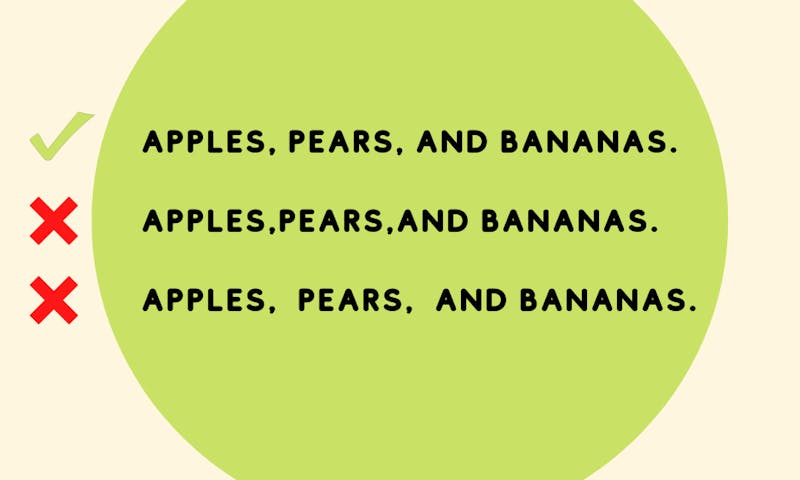The Comma Rules in English Punctuation
More content
Have you ever searched for what this is ( , ) called? If you have, this is a comma. A comma is an English punctuation mark that helps sentences flow; however, many people don’t know the comma rules.
Commas are used inside sentences; they act like pauses between speaking to help sentences flow.
Formatting Rules With Sentence Examples
When using a comma, there are some specific formatting rules to follow, mostly with spacing.
Always put a space after a comma. Never before!
Comma Grammar Rules
First, we’ll look into the things you can do with commas.
Adverbs & Adjectives
You can use a comma between two adjectives instead of ‘and.’
- It was a small, simple bouquet.
Commas are also used before three or more adjectives or adverbs.
- Gerty is strong-willed, impatient, and mean.
- She wanted to know how expensive, agile, and powerful the car was.
Before ‘And’ & ‘But’
Use a comma before coordinating conjunctions like ‘and, but, or, yet, so, nor’ when they connect two complete clauses.
- She was walking, and she saw her friend crossing the block.
However, make sure that you’re not adding unnecessary information. For example, you can eliminate the comma if you remove the second pronoun, ‘she.’
- She was walking and saw her friend crossing the block.
This rule doesn’t always apply for ‘but, nor, or yet,’ but sometimes it does, depending on the sentence. The following sentences are all grammatically correct.
- Harry was old, yet he had a youthful personality. ✅
- Harry was old yet had a youthful personality. ✅
Addresses, Dates & Titles
Use a comma if a name follows specific dates, titles, or addresses.
Addresses
When writing addresses, place a comma between the street name and another one between the city and state.
- 15th North Avenue, Los Angeles, CA 1234.
Note: you don’t need to place commas between states and zip codes.
If an address falls in the middle of a sentence, you need to add a comma after it.
- My aunty has lived at 15th North Avenue, Los Angeles, for 10 years.
Dates
Use a comma to separate the weekday from the month and another for the year.
- Thursday, the 31st of August, 1995.
However, you don’t have to use a comma if you’re just writing the month and year.
- I met my best friend in August 1995.
If you’re writing the month, day, and year, only use a comma before the year.
- I met my best friend on August 16th, 1995.
If the date is at the beginning of the sentence, use a comma after the year.
- August 16th, 1995, is when I met my best friend.
Titles
Placing commas in titles is tricky because it depends on your context and style guide.
Generally speaking, If there’s a name or title in a sentence's ending word(s), you can choose to use commas.
- Barack Obama, former president of The United States of America.
- The former president of The United States of America is Barack Obama
- My good friend, Barack Obama, is the former president of The United States of America.
Note: if a comma is placed in a title, the name isn’t essential for the sentence to make sense. However, the name is important if a comma isn’t placed in the title.
Directly Addressing
Use a comma after or before the direct speech but never for reported speech.
- They said, "they were coming over for dinner."
Listing
Always use a comma for lists or series of words. This is called an Oxford Comma or a Serial Comma. Some style guides don’t require it.
- We need to buy bananas, eggs, cheese, and greek yogurt.
- My favorite bands are The Beatles, The Kooks, and Queen.
Numbers
Numbers over 999 need commas. However, only when writing the number numerically.
- 3, 500
- 1, 000
- Three thousand five hundred
- One thousand
Parenthetical Remarks
Parenthetical remarks are elements of a sentence that add information, but the sentence still makes sense if they are taken away; we use commas for these.
- My dad, the breadwinner of the house, is retiring early.
Questions
Use a comma when you want to separate a question and a statement.
- I can’t go, can I?
You also use a comma when you want to separate different parts of a sentence.
- I think that’s mine, isn’t it?
Quotations
In American English, periods and commas always go inside the quote.
- "We went there for dinner, but the service was terrible," said John.
Flashcards
Check out these flashcards and test your knowledge!
When is a Comma Unnecessary?
Sometimes, a comma is unnecessary, so it’s worth learning when not to use one.
Don’t use a comma between the subject and the verb.
- The student studied hard. ✅
Not
- The student, studied hard. ❌
Unless the sentence is giving us more information about the subject.
- The student, who was an older gentleman, studied hard for his upcoming exams. ✅
Don't use a comma if the sentence has two or more verbs.
- The teacher talked to the class and told them about their upcoming field trip. ✅
Not
- The teacher talked to the class, and told them about their upcoming field trip. ❌
A comma is unnecessary if a sentence ends with an exclamation point or question mark.
- "Do you have any questions?" Bob said. ✅
Not
- "Do you have any questions,?" Bob said. ❌
There we have it! We hope you’ve enjoyed learning about comma grammar. If you’re after any more grammar tips, we’ve got plenty.
Comma Rules FAQs
Got a question? See if we've answered it here.
What are the 8 rules for commas?
Do I need a comma before and?
What is the Oxford comma rule?

